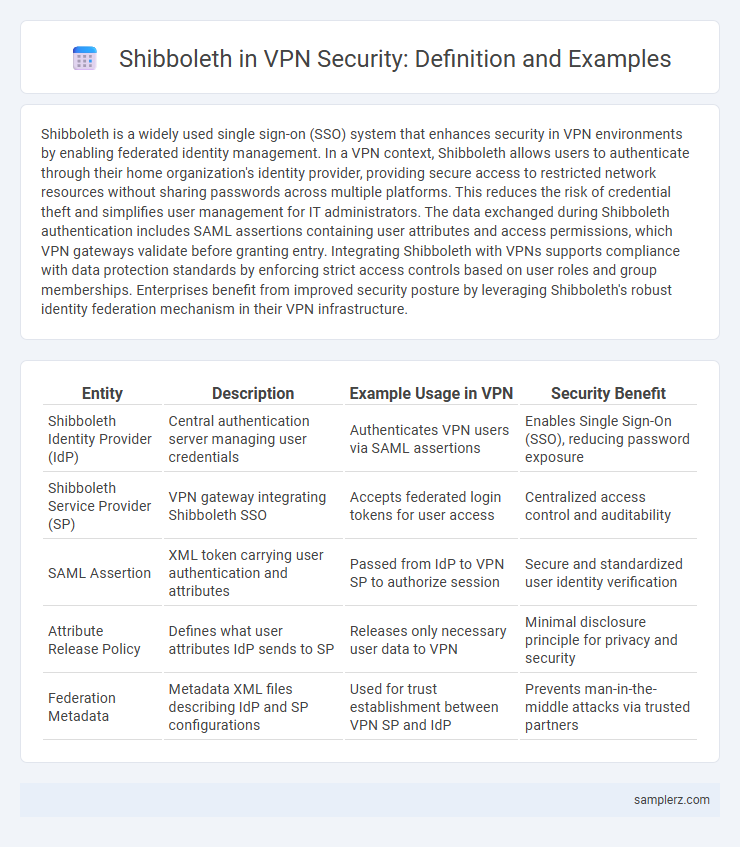Shibboleth is a widely used single sign-on (SSO) system that enhances security in VPN environments by enabling federated identity management. In a VPN context, Shibboleth allows users to authenticate through their home organization's identity provider, providing secure access to restricted network resources without sharing passwords across multiple platforms. This reduces the risk of credential theft and simplifies user management for IT administrators. The data exchanged during Shibboleth authentication includes SAML assertions containing user attributes and access permissions, which VPN gateways validate before granting entry. Integrating Shibboleth with VPNs supports compliance with data protection standards by enforcing strict access controls based on user roles and group memberships. Enterprises benefit from improved security posture by leveraging Shibboleth's robust identity federation mechanism in their VPN infrastructure.
Table of Comparison
| Entity | Description | Example Usage in VPN | Security Benefit |
|---|---|---|---|
| Shibboleth Identity Provider (IdP) | Central authentication server managing user credentials | Authenticates VPN users via SAML assertions | Enables Single Sign-On (SSO), reducing password exposure |
| Shibboleth Service Provider (SP) | VPN gateway integrating Shibboleth SSO | Accepts federated login tokens for user access | Centralized access control and auditability |
| SAML Assertion | XML token carrying user authentication and attributes | Passed from IdP to VPN SP to authorize session | Secure and standardized user identity verification |
| Attribute Release Policy | Defines what user attributes IdP sends to SP | Releases only necessary user data to VPN | Minimal disclosure principle for privacy and security |
| Federation Metadata | Metadata XML files describing IdP and SP configurations | Used for trust establishment between VPN SP and IdP | Prevents man-in-the-middle attacks via trusted partners |
Understanding Shibboleth: A Brief Overview
Shibboleth integrates with VPN systems to provide secure, federated identity management by enabling single sign-on (SSO) capabilities across multiple organizations. It utilizes Security Assertion Markup Language (SAML) to authenticate users, ensuring that VPN access is granted only after verification by a trusted identity provider. By facilitating seamless and secure authentication, Shibboleth enhances VPN security while simplifying user access management in distributed environments.
The Role of Shibboleth in Enhancing VPN Security
Shibboleth enhances VPN security by providing robust federated identity management, allowing users to authenticate across multiple organizations without sharing passwords. Its single sign-on (SSO) capabilities reduce the risk of credential theft and unauthorized access in VPN environments. Implementing Shibboleth in VPNs ensures seamless, secure authentication and precise access control based on user attributes, improving overall network protection.
How Shibboleth Authenticates VPN Users
Shibboleth authenticates VPN users by leveraging federated identity management, allowing seamless single sign-on (SSO) through Security Assertion Markup Language (SAML) protocols. When a VPN connection request is made, Shibboleth redirects users to their home institution's identity provider (IdP) to verify credentials securely without exposing passwords to the VPN service. This method ensures robust authentication, reduces password fatigue, and enables centralized access control across multiple organizations within a federated network.
Shibboleth Integration with VPN Gateways
Shibboleth integration with VPN gateways enhances secure remote access by enabling federated identity management and single sign-on (SSO) capabilities. This integration allows VPN gateways to authenticate users via Shibboleth's SAML-based assertions, ensuring consistent access control across multiple networks and institutions. Implementing Shibboleth with VPNs reduces administrative overhead while strengthening authentication mechanisms critical for protecting sensitive data in distributed environments.
Real-World Examples of Shibboleth in VPN Deployment
Shibboleth integrates with VPNs by enabling single sign-on (SSO) authentication, streamlining secure access to corporate networks without repeatedly entering credentials. Organizations like universities use Shibboleth in VPN setups to verify user identity via federated authentication, ensuring only authorized students and staff connect remotely. This approach enhances security by leveraging identity federation standards such as SAML, reducing the risk of credential theft and improving user experience in VPN deployment.
Benefits of Using Shibboleth for VPN Access Control
Shibboleth enhances VPN access control by providing secure, single sign-on authentication through SAML-based federated identity management, reducing the risk of unauthorized access. It enables centralized user authentication while allowing seamless integration with various organizational identity providers. This approach improves security compliance and user experience by enforcing consistent access policies across multiple VPN endpoints.
Shibboleth vs. Traditional VPN Authentication Methods
Shibboleth enhances VPN security by providing federated identity management, allowing users to authenticate through their home organization's credentials without exposing passwords to the VPN server. Traditional VPN authentication methods often rely on static credentials or simple multi-factor authentication, which can be more vulnerable to phishing and credential theft. By integrating Shibboleth, organizations leverage SAML-based single sign-on (SSO) and attribute-based access control, improving both user convenience and security posture compared to conventional VPN authentication protocols.
Step-by-Step: Setting Up Shibboleth with VPNs
Configuring Shibboleth with VPNs begins by installing the Shibboleth Service Provider (SP) software on the VPN gateway to enable secure authentication. Next, integrate the SP with the Identity Provider (IdP) by exchanging metadata XML files and configuring trust relationships for seamless Single Sign-On (SSO). Finally, test the VPN connection to ensure that authentication requests redirect correctly to the IdP, allowing authorized users secure access through Shibboleth-enabled VPN authentication.
Common Challenges When Implementing Shibboleth in VPNs
Shibboleth integration in VPNs frequently encounters challenges such as complex configuration requirements and interoperability issues with existing network infrastructure. Ensuring robust identity federation while maintaining low latency and high availability can strain system resources and complicate troubleshooting. Addressing certificate management and user attribute synchronization is critical to prevent authentication failures and enhance overall security in VPN environments.
Future Trends: Shibboleth and the Evolution of VPN Security
Shibboleth integration is transforming VPN security by enabling seamless, federated identity management that enhances user authentication and access control. Future trends point to advanced multi-factor authentication and decentralized identity protocols embedded within Shibboleth-enabled VPNs, reducing reliance on passwords and minimizing breach risks. This evolution supports scalable, secure remote access for enterprises while aligning with Zero Trust security models and cloud-based infrastructure demands.

example of shibboleth in VPN Infographic
 samplerz.com
samplerz.com